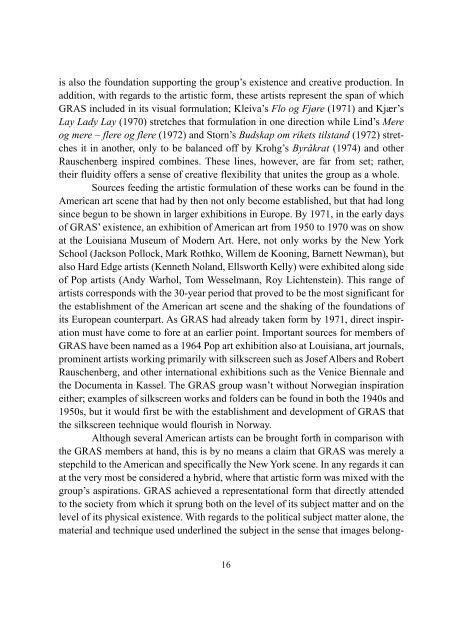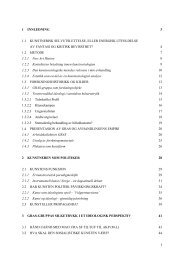2003 Rogaland museum - Gras Katalog - Victor Lind
2003 Rogaland museum - Gras Katalog - Victor Lind
2003 Rogaland museum - Gras Katalog - Victor Lind
Create successful ePaper yourself
Turn your PDF publications into a flip-book with our unique Google optimized e-Paper software.
is also the foundation supporting the group’s existence and creative production. In<br />
addition, with regards to the artistic form, these artists represent the span of which<br />
GRAS included in its visual formulation; Kleiva’s Flo og Fjøre (1971) and Kjær’s<br />
Lay Lady Lay (1970) stretches that formulation in one direction while <strong>Lind</strong>’s Mere<br />
og mere – flere og flere (1972) and Storn’s Budskap om rikets tilstand (1972) stretches<br />
it in another, only to be balanced off by Krohg’s Byråkrat (1974) and other<br />
Rauschenberg inspired combines. These lines, however, are far from set; rather,<br />
their fluidity offers a sense of creative flexibility that unites the group as a whole.<br />
Sources feeding the artistic formulation of these works can be found in the<br />
American art scene that had by then not only become established, but that had long<br />
since begun to be shown in larger exhibitions in Europe. By 1971, in the early days<br />
of GRAS’ existence, an exhibition of American art from 1950 to 1970 was on show<br />
at the Louisiana Museum of Modern Art. Here, not only works by the New York<br />
School (Jackson Pollock, Mark Rothko, Willem de Kooning, Barnett Newman), but<br />
also Hard Edge artists (Kenneth Noland, Ellsworth Kelly) were exhibited along side<br />
of Pop artists (Andy Warhol, Tom Wesselmann, Roy Lichtenstein). This range of<br />
artists corresponds with the 30-year period that proved to be the most significant for<br />
the establishment of the American art scene and the shaking of the foundations of<br />
its European counterpart. As GRAS had already taken form by 1971, direct inspiration<br />
must have come to fore at an earlier point. Important sources for members of<br />
GRAS have been named as a 1964 Pop art exhibition also at Louisiana, art journals,<br />
prominent artists working primarily with silkscreen such as Josef Albers and Robert<br />
Rauschenberg, and other international exhibitions such as the Venice Biennale and<br />
the Documenta in Kassel. The GRAS group wasn’t without Norwegian inspiration<br />
either; examples of silkscreen works and folders can be found in both the 1940s and<br />
1950s, but it would first be with the establishment and development of GRAS that<br />
the silkscreen technique would flourish in Norway.<br />
Although several American artists can be brought forth in comparison with<br />
the GRAS members at hand, this is by no means a claim that GRAS was merely a<br />
stepchild to the American and specifically the New York scene. In any regards it can<br />
at the very most be considered a hybrid, where that artistic form was mixed with the<br />
group’s aspirations. GRAS achieved a representational form that directly attended<br />
to the society from which it sprung both on the level of its subject matter and on the<br />
level of its physical existence. With regards to the political subject matter alone, the<br />
material and technique used underlined the subject in the sense that images belong-<br />
16



